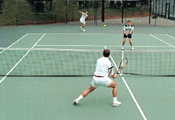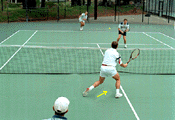|
TennisOne Lessons

2. Movement: Diagonally Towards the Net
In the first photo below (foreground) I am beginning to move across to
intercept the return of the player in the deuce court. I begin my movement
just as the ball has bounced and my opponent's eyes are focused down
towards the ball. At this moment he can no longer look to see if I am
poaching, and this sightless moment is exactly when I should start
to cross. If I start any sooner my opponent will detect my movement in his
peripheral vision and pass me down my unguarded alley. Also take
note of my initial movement - across the court and closer to the net.
This "closing on the diagonal" is key to being right on top of
the net and intercepting the return.

In the photo below, the ball has just left the opponent's racquet and is
headed towards the middle of net. I see the sitting duck and I am now in
the full poaching mode. The key position to note is the initial setup of
my racquet and the shift of weight onto my right foot. Club players cannot
practice this initial move often enough. From the balanced and centered
ready position, I have simply made a subtle turn of my shoulders and hips,
and have unweighted my left leg. Stay tuned!

In the next photo I continue across the court, and at the same time move
even closer to the net. Again, notice the racquet and foot. I have placed
the strings exactly in the flight path of the ball and my left leg is more
unweighted. Study this position - a classic position of all the great
volleyers: racquet face up and in the way of the ball, weight entirely shifted
to the right side, and hips turned just enough so I can easily and quickly
move diagonally to the ball.

Go To:
Next Page
Previous Page
Back to TennisONE Home Page
What's New | Tennis
Lessons | Tennis
in Your Area
Tennis Fitness | Tennis
Products | Sponsors/Advertisers/Consultants
webmaster@tennisone.com
TennisONE© is a trademark of TennisONE© and SportsWeb ONE©.
Copyright© 1995. All rights reserved.
|


